Mechanical, Barrier and Thermal Properties of Amylose-Argan Proteins-Based Bioplastics in the Presence of Transglutaminase
Abstract
:1. Introduction
2. Results and Discussion
2.1. Transglutaminase Assay
2.2. Two-Dimensional Polyacrylamide Gel Electrophoresis (2-D PAGE)
2.3. Zeta Potential Analysis of Film Forming Solutions (FFSs) Prepared Blending AM and APs in the Absence and the Presence of mTGase
2.4. Opacity, Density, Thickness, and Morphology
2.5. Film Mechanical Properties
2.6. Moisture Content, Water Solubility, Swelling Ratio
2.7. Water Vapor Permeability (WVP) and CO2 Permeability (CO2P)
2.8. Fourier Transform Infrared Spectra (FT-IR)
2.9. Thermogravimetric Analysis (TGA)
2.10. Differential Scanning Calorimetry (DSC)
3. Materials and Methods
3.1. Materials
3.2. Preparation of APs Concentrate
3.3. Transglutaminase Assay
3.4. Two-Dimensional Polyacrylamide Gel Electrophoresis (2-D PAGE)
3.5. Preparation of FFSs
3.6. Zeta Potential
3.7. Films Preparation
3.8. Film Characterization
3.8.1. Film Transparency
3.8.2. Film Density
3.8.3. Morphology
3.8.4. Film Mechanical Properties
3.8.5. CO2 and Water Vapor Permeability
3.8.6. Moisture Content and Solubility
3.8.7. Swelling Ratio
3.8.8. Fourier Transform Infrared Spectra (FT-IR)
3.8.9. Thermogravimetric Analyses (TGA)
3.8.10. Differential Scanning Calorimetry (DSC)
3.9. Statistical Analysis
4. Conclusions
Author Contributions
Funding
Institutional Review Board Statement
Informed Consent Statement
Data Availability Statement
Acknowledgments
Conflicts of Interest
Abbreviations
| APs | Argan Proteins |
| AM | Amylose |
| APC | Argan Press Cake |
| mTGase | Microbial transglutaminase |
| FFSs | Film-Forming Solutions |
| TS | Tensile Strength |
| EB | Elongation at Break |
| YM | Young’s Modulus |
| WVP | Water Vapor Permeability |
| CO2P | CO2 Permeability |
| FT-IR | Fourier Transform Infrared Spectra |
| TGA | Thermogravimetric Analysis |
| DSC | Differential Scanning Calorimetry |
References
- Geyer, R.; Jambeck, J.R.; Law, K.L. Production, Use, and Fate of All Plastics Ever Made. Sci. Adv. 2017, 3, 25–29. [Google Scholar] [CrossRef] [PubMed]
- Ford, H.V.; Jones, N.H.; Davies, A.J.; Godley, B.J.; Jambeck, J.R.; Napper, I.E.; Suckling, C.C.; Williams, G.J.; Woodall, L.C.; Koldewey, H.J. The Fundamental Links between Climate Change and Marine Plastic Pollution. Sci. Total Environ. 2022, 806, 150392. [Google Scholar] [CrossRef] [PubMed]
- Law, K.L.; Narayan, R. Reducing Environmental Plastic Pollution by Designing Polymer Materials for Managed End-of-Life. Nat. Rev. Mater. 2022, 7, 104–116. [Google Scholar] [CrossRef]
- Zheng, J.; Suh, S. Strategies to Reduce the Global Carbon Footprint of Plastics. Nat. Clim. Chang. 2019, 9, 374–378. [Google Scholar] [CrossRef]
- Hottle, T.A.; Bilec, M.M.; Landis, A.E. Biopolymer Production and End of Life Comparisons Using Life Cycle Assessment. Resour. Conserv. Recycl. 2017, 122, 295–306. [Google Scholar] [CrossRef]
- Abe, M.M.; Martins, J.R.; Sanvezzo, P.B.; Macedo, J.V.; Branciforti, M.C.; Halley, P.; Botaro, V.R.; Brienzo, M. Advantages and Disadvantages of Bioplastics Production from Starch and Lignocellulosic Components. Polymers 2021, 13, 2484. [Google Scholar] [CrossRef] [PubMed]
- Blennow, A. Starch Bioengineering; Elsevier Ltd.: Amsterdam, The Netherlands, 2018; ISBN 9780081008966. [Google Scholar]
- Domene-López, D.; García-Quesada, J.C.; Martin-Gullon, I.; Montalbán, M.G. Influence of Starch Composition and Molecular Weight on Physicochemical Properties of Biodegradable Films. Polymers 2019, 11, 1084. [Google Scholar] [CrossRef]
- Seung, D. Amylose in Starch: Towards an Understanding of Biosynthesis, Structure and Function. New Phytol. 2020, 228, 1490–1504. [Google Scholar] [CrossRef]
- Li, H.; Gidley, M.J.; Dhital, S. High-Amylose Starches to Bridge the “Fiber Gap”: Development, Structure, and Nutritional Functionality. Compr. Rev. Food Sci. Food Saf. 2019, 18, 362–379. [Google Scholar] [CrossRef]
- Goderis, B.; Putseys, J.A.; Gommes, C.J.; Bosmans, G.M.; Delcour, J.A. The Structure and Thermal Stability of Amylose-Lipid Complexes: A Case Study on Amylose-Glycerol Monostearate. Cryst. Growth Des. 2014, 14, 3221–3233. [Google Scholar] [CrossRef]
- Wang, S.; Li, C.; Copeland, L.; Niu, Q.; Wang, S. Starch Retrogradation: A Comprehensive Review. Compr. Rev. Food Sci. Food Saf. 2015, 14, 568–585. [Google Scholar] [CrossRef]
- Xu, J.; Sagnelli, D.; Faisal, M.; Perzon, A.; Taresco, V.; Mais, M.; Giosafatto, C.V.L.; Hebelstrup, K.H.; Ulvskov, P.; Jørgensen, B.; et al. Amylose/Cellulose Nanofiber Composites for All-Natural, Fully Biodegradable and Flexible Bioplastics. Carbohydr. Polym. 2021, 253, 117277. [Google Scholar] [CrossRef] [PubMed]
- Faisal, M.; Kou, T.; Zhong, Y.; Blennow, A. High Amylose-Based Bio Composites: Structures, Functions and Applications. Polymers 2022, 14, 1235. [Google Scholar] [CrossRef] [PubMed]
- Sagnelli, D.; Hooshmand, K.; Kemmer, G.C.; Kirkensgaard, J.J.K.; Mortensen, K.; Giosafatto, C.V.L.; Holse, M.; Hebelstrup, K.H.; Bao, J.; Stelte, W.; et al. Cross-Linked Amylose Bio-Plastic: A Transgenic-Based Compostable Plastic Alternative. Int. J. Mol. Sci. 2017, 18, 2075. [Google Scholar] [CrossRef] [PubMed]
- Carciofi, M.; Blennow, A.; Jensen, S.L.; Shaik, S.S.; Henriksen, A.; Buléon, A.; Holm, P.B.; Hebelstrup, K.H. Concerted Suppression of All Starch Branching Enzyme Genes in Barley Produces Amylose-Only Starch Granules. BMC Plant Biol. 2012, 12, 223. [Google Scholar] [CrossRef] [PubMed]
- Mirpoor, S.F.; Giosafatto, C.V.L.; Di Girolamo, R.; Famiglietti, M.; Porta, R. Hemp (Cannabis Sativa) Seed Oilcake as a Promising by-Product for Developing Protein-Based Films: Effect of Transglutaminase-Induced Crosslinking. Food Packag. Shelf Life 2022, 31, 100779. [Google Scholar] [CrossRef]
- Mirpoor, S.F.; Varriale, S.; Porta, R.; Naviglio, D.; Spennato, M.; Gardossi, L.; Giosafatto, C.V.L.; Pezzella, C. A Biorefinery Approach for the Conversion of Cynara Cardunculus Biomass to Active Films. Food Hydrocoll. 2022, 122, 107099. [Google Scholar] [CrossRef]
- Mirpoor, S.F.; Giosafatto, C.V.L.; Mariniello, L.; D’Agostino, A.; D’Agostino, M.; Cammarota, M.; Schiraldi, C.; Porta, R. Argan (Argania spinosa L.) Seed Oil Cake as a Potential Source of Protein-Based Film Matrix for Pharmaco-Cosmetic Spplications. Int. J. Mol. Sci. 2022, 23, 8478. [Google Scholar] [CrossRef]
- Mirpoor, S.F.; Giosafatto, C.V.L.; Porta, R. Biorefining of Seed Oil Cakes as Industrial Co-Streams for Production of Innovative Bioplastics. A Review. Trends Food Sci. Technol. 2021, 109, 259–270. [Google Scholar] [CrossRef]
- Taarji, N.; Rabelo da Silva, C.A.; Khalid, N.; Gadhi, C.; Hafidi, A.; Kobayashi, I.; Neves, M.A.; Isoda, H.; Nakajima, M. Formulation and Stabilization of Oil-in-Water Nanoemulsions Using a Saponins-Rich Extract from Argan Oil Press-Cake. Food Chem. 2018, 246, 457–463. [Google Scholar] [CrossRef] [Green Version]
- Rahib, Y.; Sarh, B.; Chaoufi, J.; Bonnamy, S.; Elorf, A. Physicochemical and Thermal Analysis of Argan Fruit Residues (AFRs) as a New Local Biomass for Bioenergy Production. J. Therm. Anal. Calorim. 2021, 145, 2405–2416. [Google Scholar] [CrossRef]
- Lakram, N.; Moutik, S.; Mercha, I.; El Maadoudi, E.H.; Kabbour, R.; Douaik, A.; Zouahri, A.; El Housni, A.; Naciri, M. Effects of the Inclusion of Detoxified Argan Press Cake in the Diet of Dairy Goats on Milk Production and Milk Quality. Turkish J. Vet. Anim. Sci. 2019, 43, 323–333. [Google Scholar] [CrossRef]
- Al-Asmar, A.; Giosafatto, C.V.L.; Sabbah, M.; Mariniello, L. Hydrocolloid-Based Coatings with Nanoparticles and Transglutaminase Crosslinker as Innovative Strategy to Produce Healthier Fried Kobbah. Foods 2020, 9, 698. [Google Scholar] [CrossRef] [PubMed]
- Al-Asmar, A.; Giosafatto, C.V.L.; Panzella, L.; Mariniello, L. The Effect of Transglutaminase to Improve the Quality of Either Traditional or Pectin-Coated Falafel (Fried Middle Eastern Food). Coatings 2019, 9, 331. [Google Scholar] [CrossRef]
- Giosafatto, C.V.L.; Al-Asmar, A.; D’Angelo, A.; Roviello, V.; Esposito, M.; Mariniello, L. Preparation and Characterization of Bioplastics from Grass Pea Flour Cast in the Presence of Microbial Transglutaminase. Coatings 2018, 8, 435. [Google Scholar] [CrossRef]
- Colussi, R.; Pinto, V.Z.; El Halal, S.L.M.; Biduski, B.; Prietto, L.; Castilhos, D.D.; da Rosa Zavareze, E.; Dias, A.R.G. Acetylated Rice Starches Films with Different Levels of Amylose: Mechanical, Water Vapor Barrier, Thermal, and Biodegradability Properties. Food Chem. 2017, 221, 1614–1620. [Google Scholar] [CrossRef]
- Muscat, D.; Adhikari, B.; Adhikari, R.; Chaudhary, D.S. Comparative Study of Film Forming Behaviour of Low and High Amylose Starches Using Glycerol and Xylitol as Plasticizers. J. Food Eng. 2012, 109, 189–201. [Google Scholar] [CrossRef]
- Seki, T.; Chiang, K.; Yu, C.; Yu, X.; Okuno, M.; Hunger, J.; Nagata, Y.; Bonn, M. The Bending Mode of Water: A Powerful Probe for Hydrogen Bond Structure of Aqueous Systems. J. Phys. Chem. Lett. 2020, 11, 8459–8469. [Google Scholar] [CrossRef]
- Simona, J.; Dani, D.; Petr, S.; Marcela, N.; Jakub, T.; Bohuslava, T. Edible Films from Carrageenan/Orange Essential Oil/Trehalose—Structure, Optical Properties, and Antimicrobial Activity. Polymers 2021, 13, 332. [Google Scholar] [CrossRef]
- Xu, X.; Liu, H.; Duan, S.; Liu, X.; Zhang, K.; Tu, J. A Novel Pumpkin Seeds Protein-Pea Starch Edible Film: Mechanical, Moisture Distribution, Surface Hydrophobicity, UV-Barrier Properties and Potential Application. Mater. Res. Express 2019, 6, 125355. [Google Scholar] [CrossRef]
- Zhang, B.; Luo, Y.; Wang, Q. Effect of Acid and Base Treatments on Structural, Rheological, and Antioxidant Properties of a -Zein. Food Chem. 2011, 124, 210–220. [Google Scholar] [CrossRef]
- Dong, S.; Guo, P.; Chen, Y.; Chen, G.; Ji, H.; Ran, Y.; Li, S.; Chen, Y. Industrial Crops & Products Surface Modi Fi Cation via Atmospheric Cold Plasma (ACP): Improved Functional Properties and Characterization of Zein Fi Lm. Ind. Crops Prod. 2018, 115, 124–133. [Google Scholar] [CrossRef]
- Zou, Y.; Yuan, C.; Cui, B.; Sha, H.; Liu, P.; Lu, L.; Wu, Z. High-Amylose Corn Starch/Konjac Glucomannan Composite Film: Reinforced by Incorporating β-Cyclodextrin. J. Agric. Food Chem. 2021, 69, 2493–2500. [Google Scholar] [CrossRef]
- Thakur, R.; Pristijono, P.; Golding, J.B.; Stathopoulos, C.E.; Scarlett, C.J.; Bowyer, M.; Singh, S.P.; Vuong, Q.V. Amylose-Lipid Complex as a Measure of Variations in Physical, Mechanical and Barrier Attributes of Rice Starch- ι -Carrageenan Biodegradable Edible Film. Food Packag. Shelf Life 2017, 14, 108–115. [Google Scholar] [CrossRef]
- Ifguis, O.; Bouhdadi, R.; Ziat, Y.; George, B.; Mbarki, M. Characterization and Analysis of Argania Spinosa Shells from Souss-Massa Area: Application in the Adsorption of Methylene Blue in Aqueous Solution. J. Nanomater. 2022, 2022, 6403838. [Google Scholar] [CrossRef]
- Zannini, D.; Dal Poggetto, G.; Malinconico, M.; Santagata, G.; Immirzi, B. Citrus Pomace Biomass as a Source of Pectin and Lignocellulose Fibers: From Waste to Upgraded Biocomposites for Mulching Applications. Polymers 2021, 13, 1280. [Google Scholar] [CrossRef]
- Turco, R.; Tesser, R.; Cucciolito, M.E.; Fagnano, M.; Ottaiano, L.; Mallardo, S.; Malinconico, M.; Santagata, G.; Di Serio, M. Cynara Cardunculus Biomass Recovery: An Eco-Sustainable, Nonedible Resource of Vegetable Oil for the Production of Poly(Lactic Acid) Bioplasticizers. ACS Sustain. Chem. Eng. 2019, 7, 4069–4077. [Google Scholar] [CrossRef]
- LDPE (Low Density Polyethylene). Available online: https://polymerdatabase.com (accessed on 30 November 2022).
- Sagnelli, D.; Hebelstrup, K.H.; Leroy, E.; Rolland-Sabaté, A.; Guilois, S.; Kirkensgaard, J.J.K.; Mortensen, K.; Lourdin, D.; Blennow, A. Plant-Crafted Starches for Bioplastics Production. Carbohydr. Polym. 2016, 152, 398–408, Corrigendum in Carbohydr. Polym.2017, 157, 903. [Google Scholar] [CrossRef]
- Damodaran, S.; Agyare, K.K. Effect of Microbial Transglutaminase Treatment on Thermal Stability and PH-Solubility of Heat-Shocked Whey Protein Isolate. Food Hydrocoll. 2013, 30, 12–18. [Google Scholar] [CrossRef]
- Jahed, E.; Khaledabad, M.A.; Bari, M.R.; Almasi, H. Effect of Cellulose and Lignocellulose Nanofibers on the Properties of Origanum Vulgare Ssp. Gracile Essential Oil-Loaded Chitosan Films. React. Funct. Polym. 2017, 117, 70–80. [Google Scholar] [CrossRef]
- Cruz-Diaz, K.; Cobos, Á.; Fernández-Valle, M.E.; Díaz, O.; Cambero, M.I. Characterization of Edible Films from Whey Proteins Treated with Heat, Ultrasounds and/or Transglutaminase. Application in Cheese Slices Packaging. Food Packag. Shelf Life 2019, 22, 100397. [Google Scholar] [CrossRef]
- Zahedi, Y.; Fathi-Achachlouei, B.; Yousefi, A.R. Physical and Mechanical Properties of Hybrid Montmorillonite/Zinc Oxide Reinforced Carboxymethyl Cellulose Nanocomposites. Int. J. Biol. Macromol. 2018, 108, 863–873. [Google Scholar] [CrossRef] [PubMed]
- Roy, S.; Rhim, J.W.; Jaiswal, L. Bioactive Agar-Based Functional Composite Film Incorporated with Copper Sulfide Nanoparticles. Food Hydrocoll. 2019, 93, 156–166. [Google Scholar] [CrossRef]

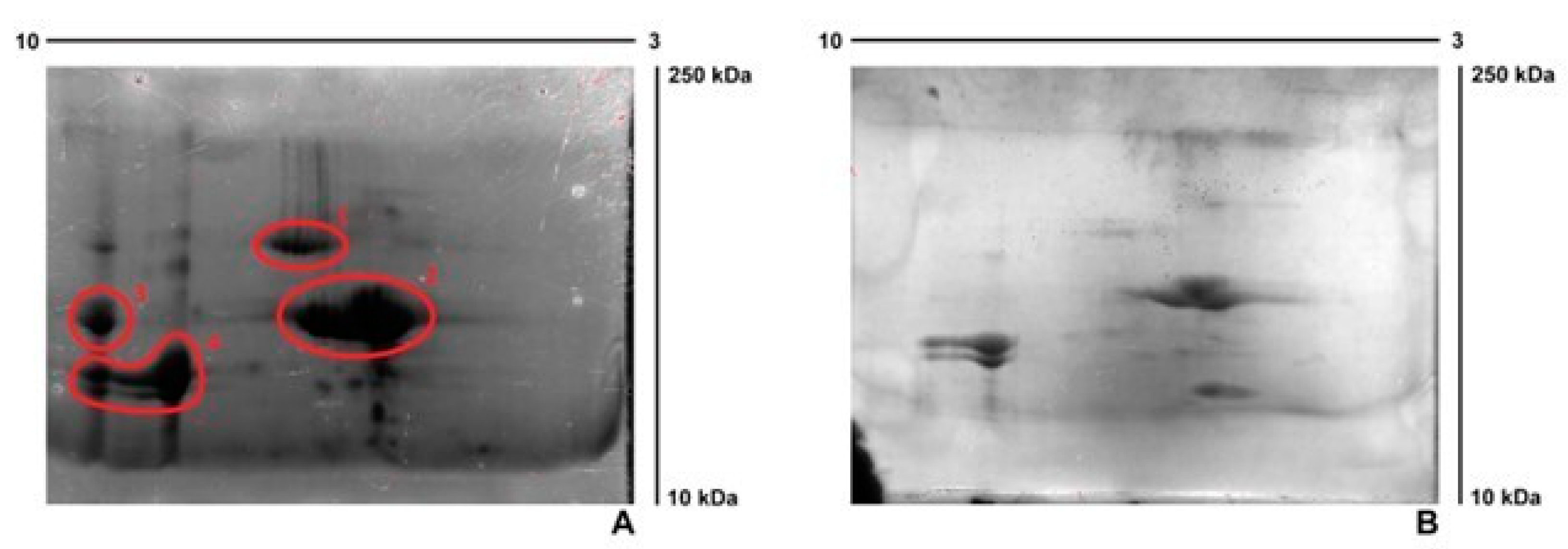
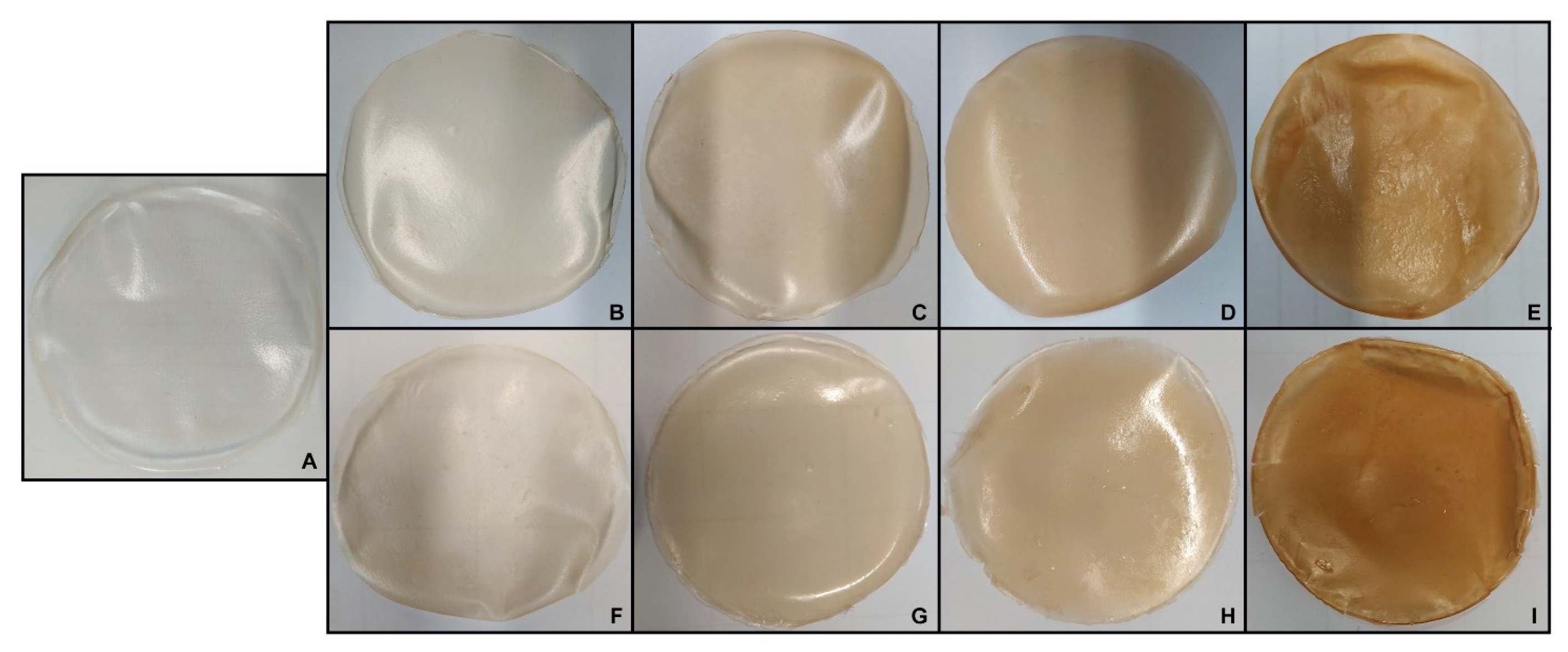
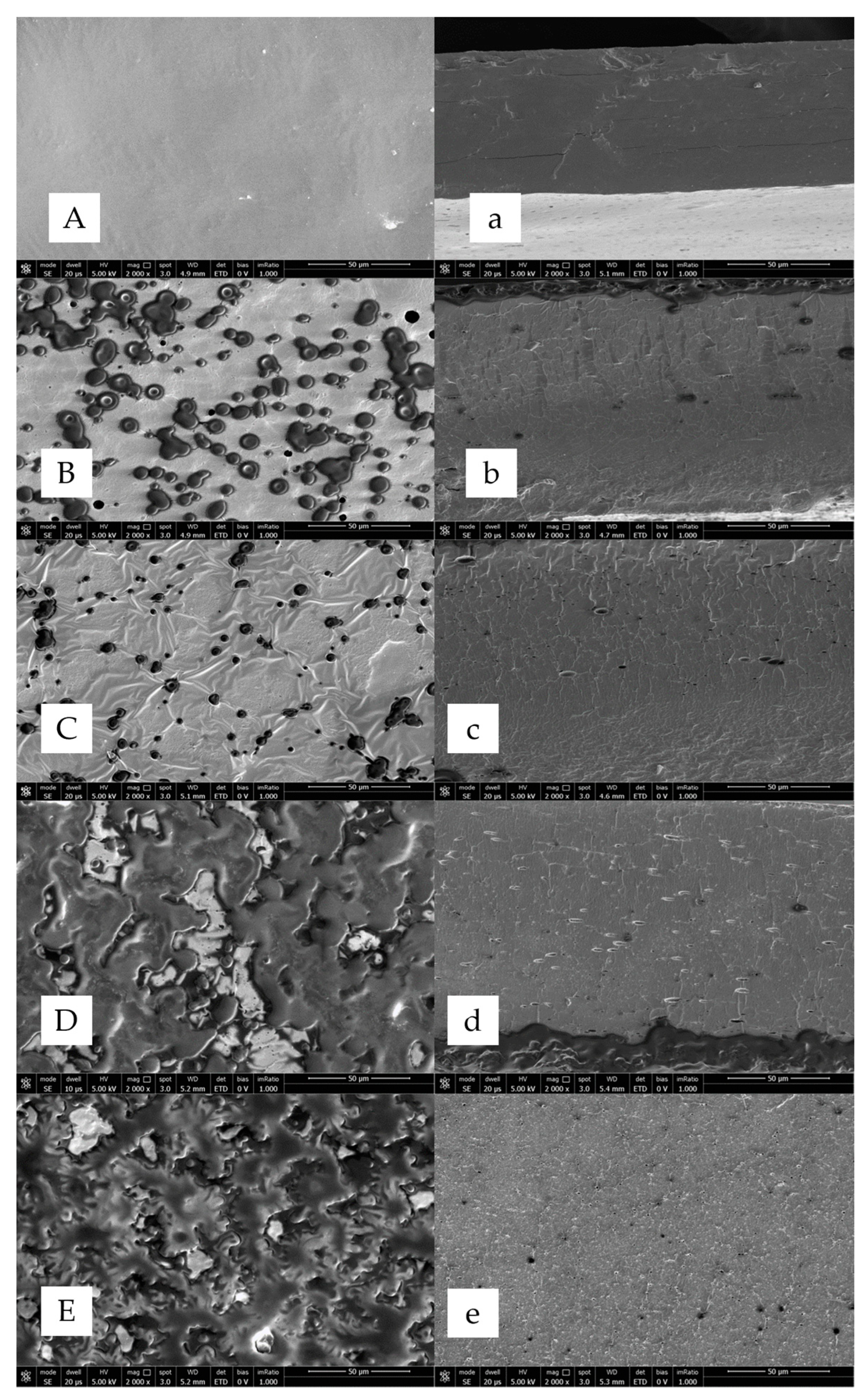
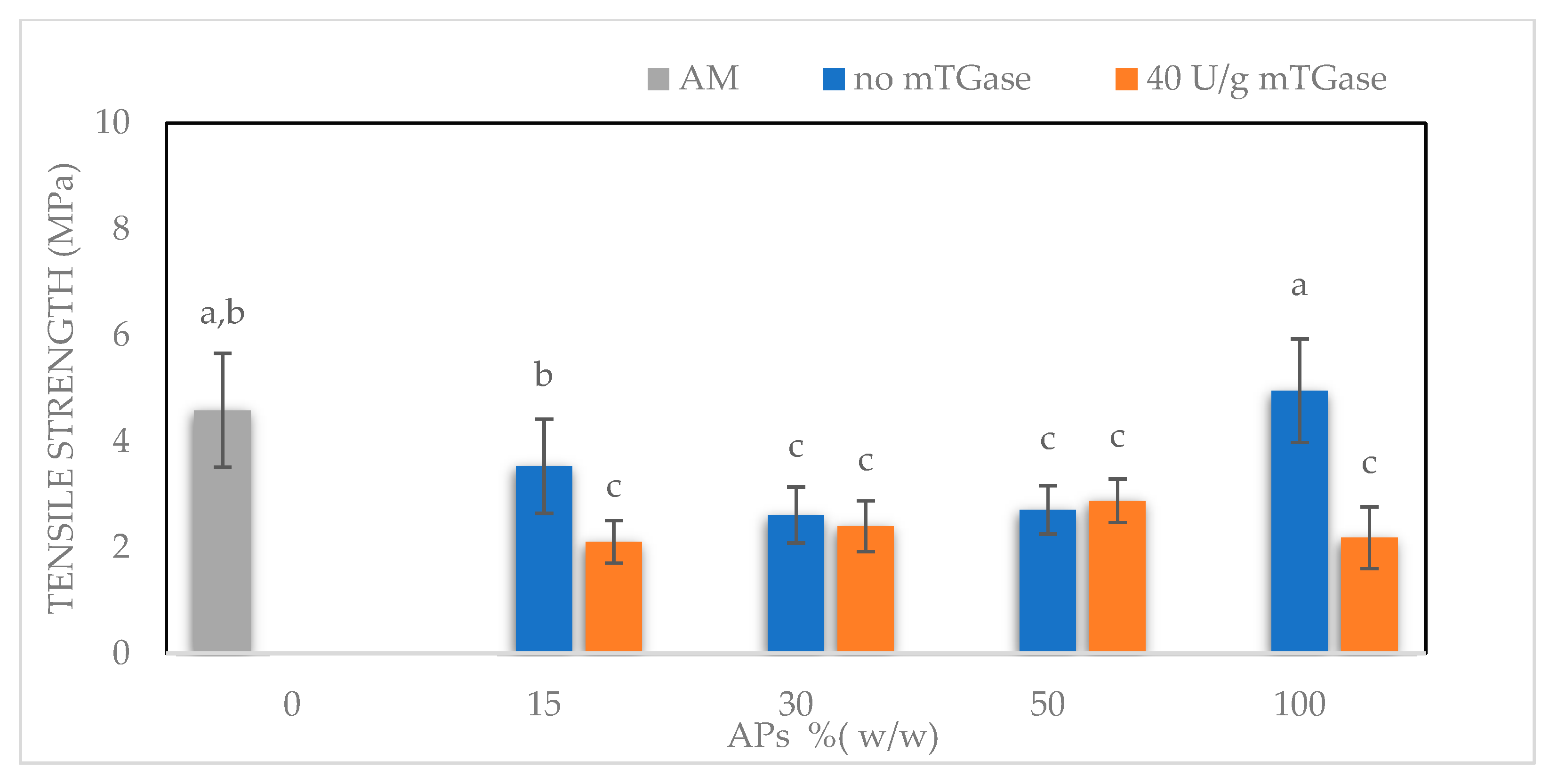
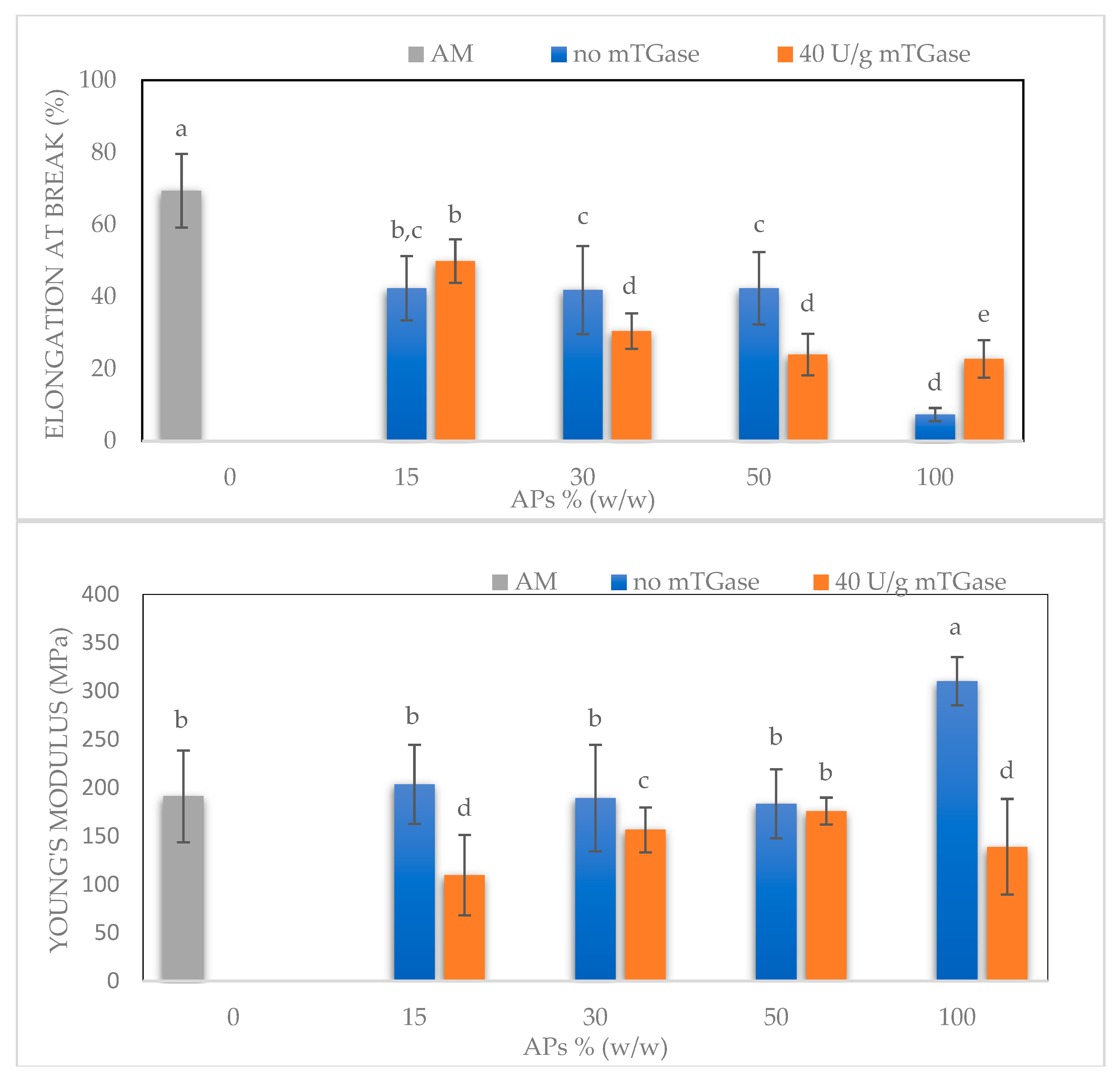
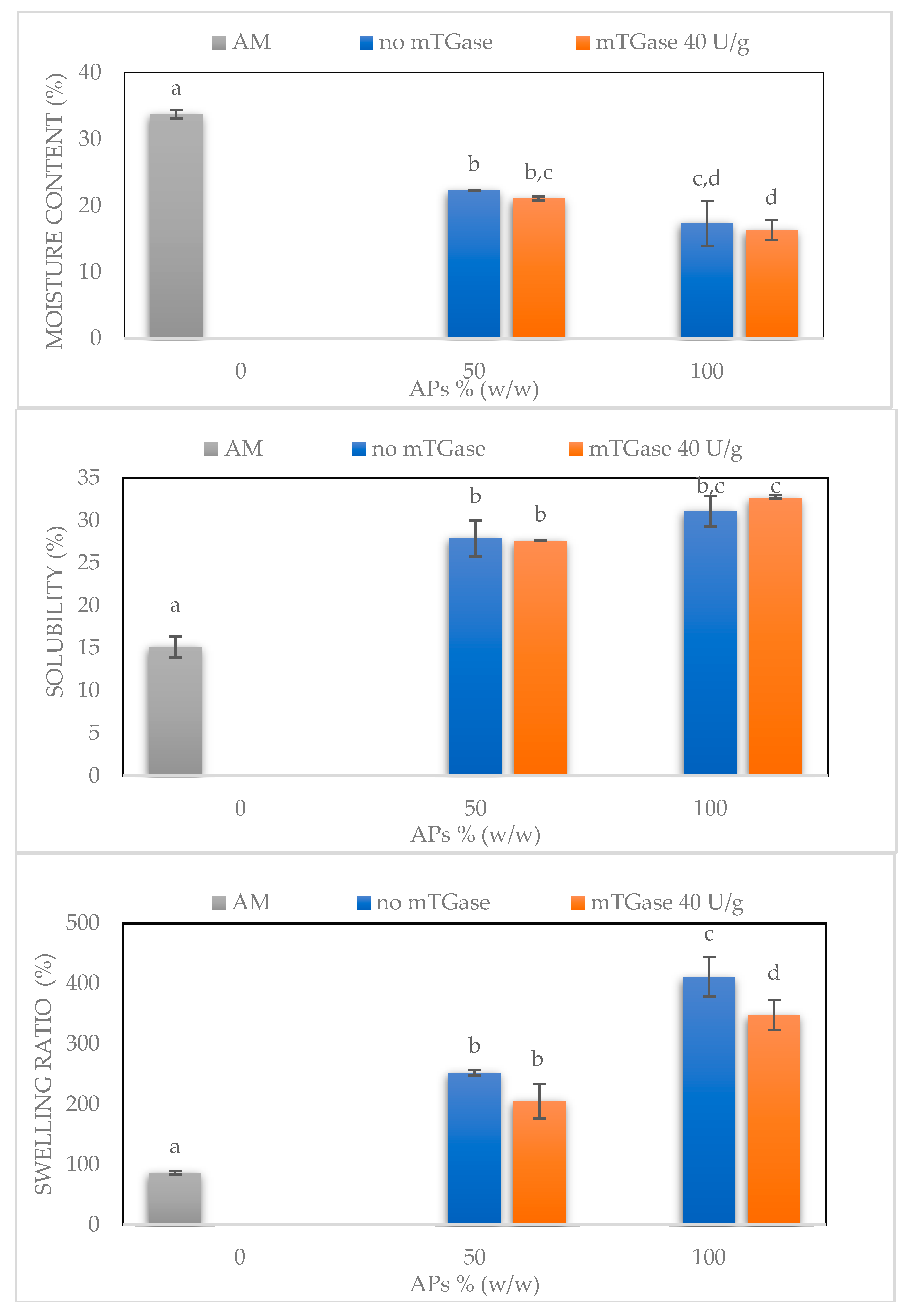
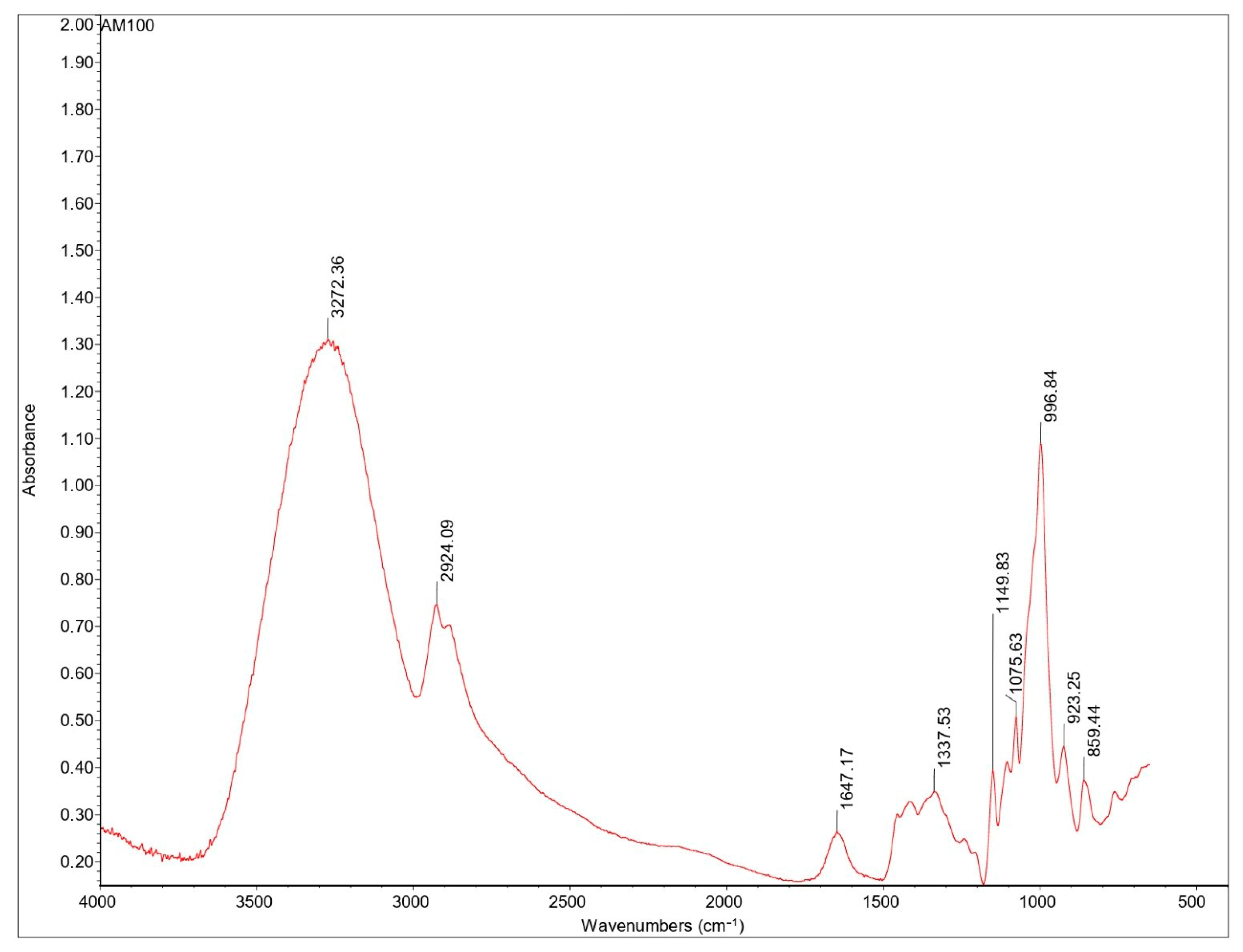
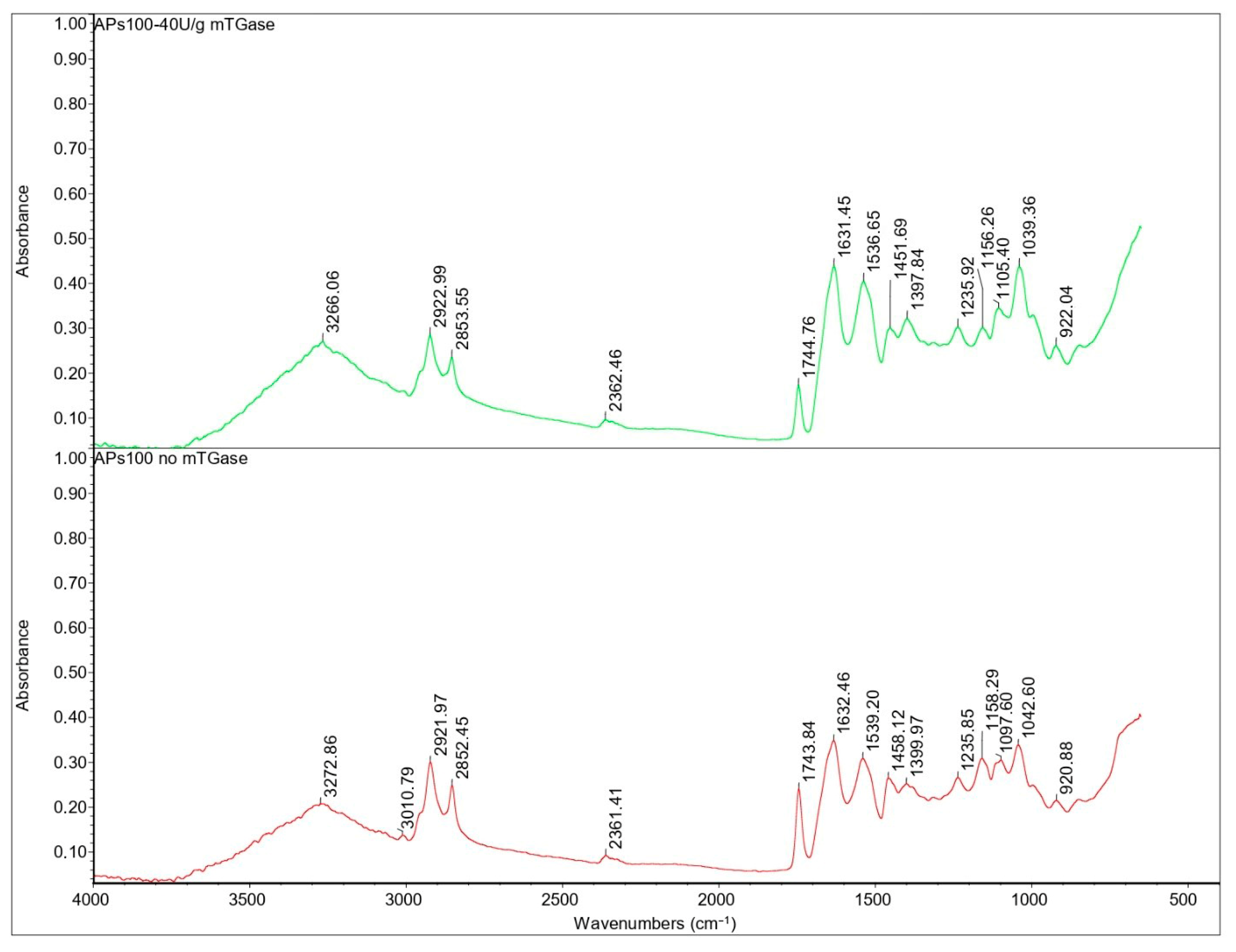
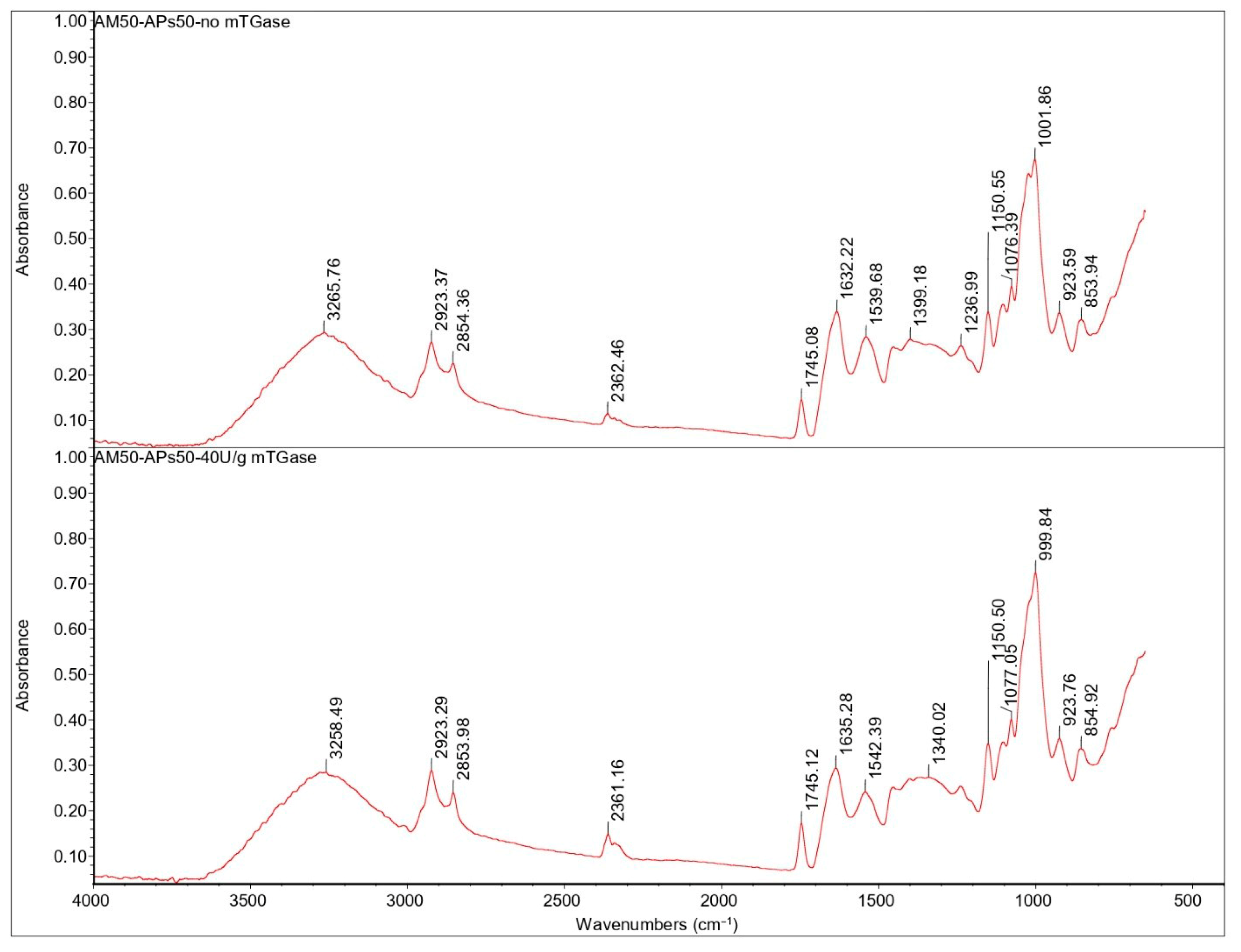
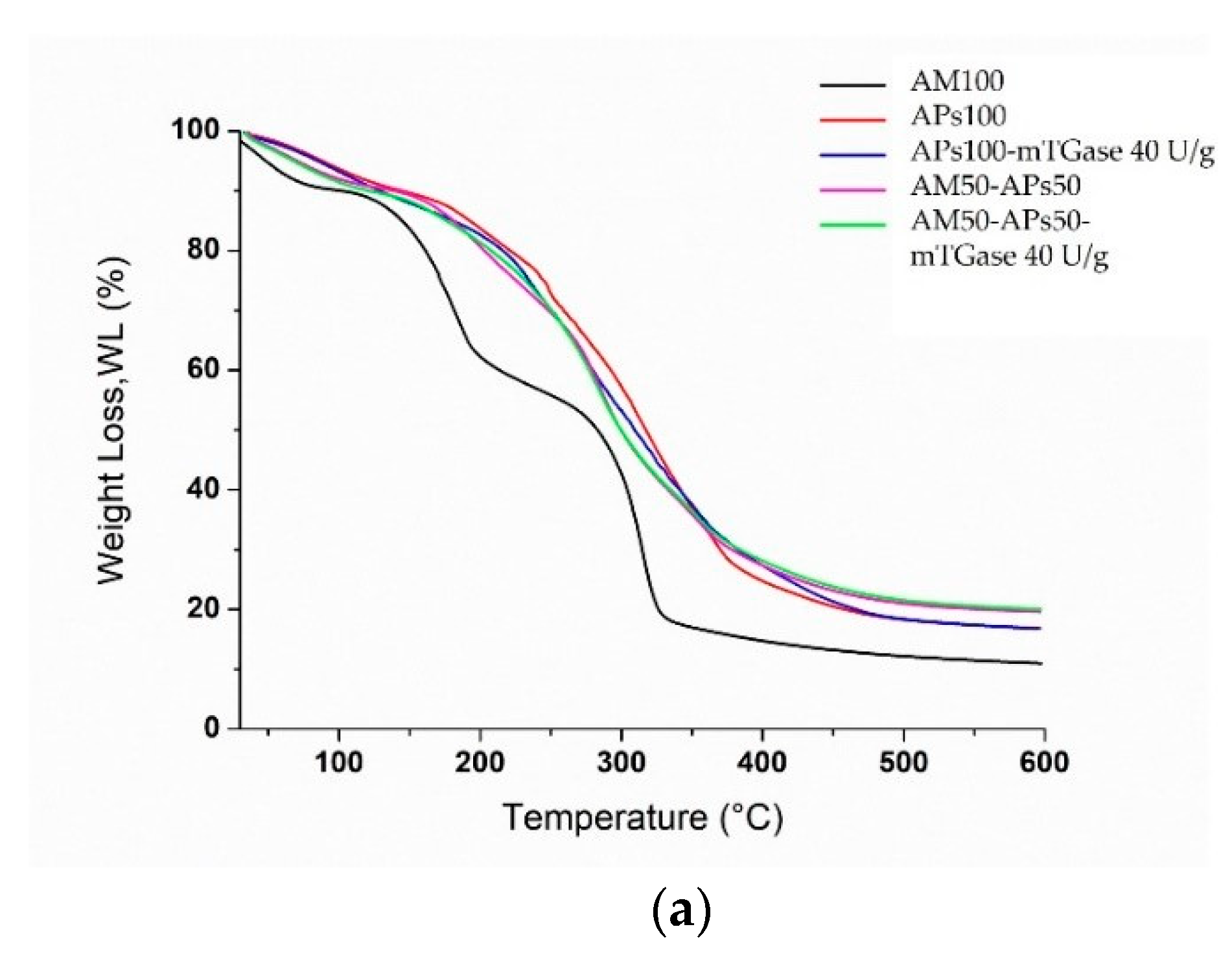
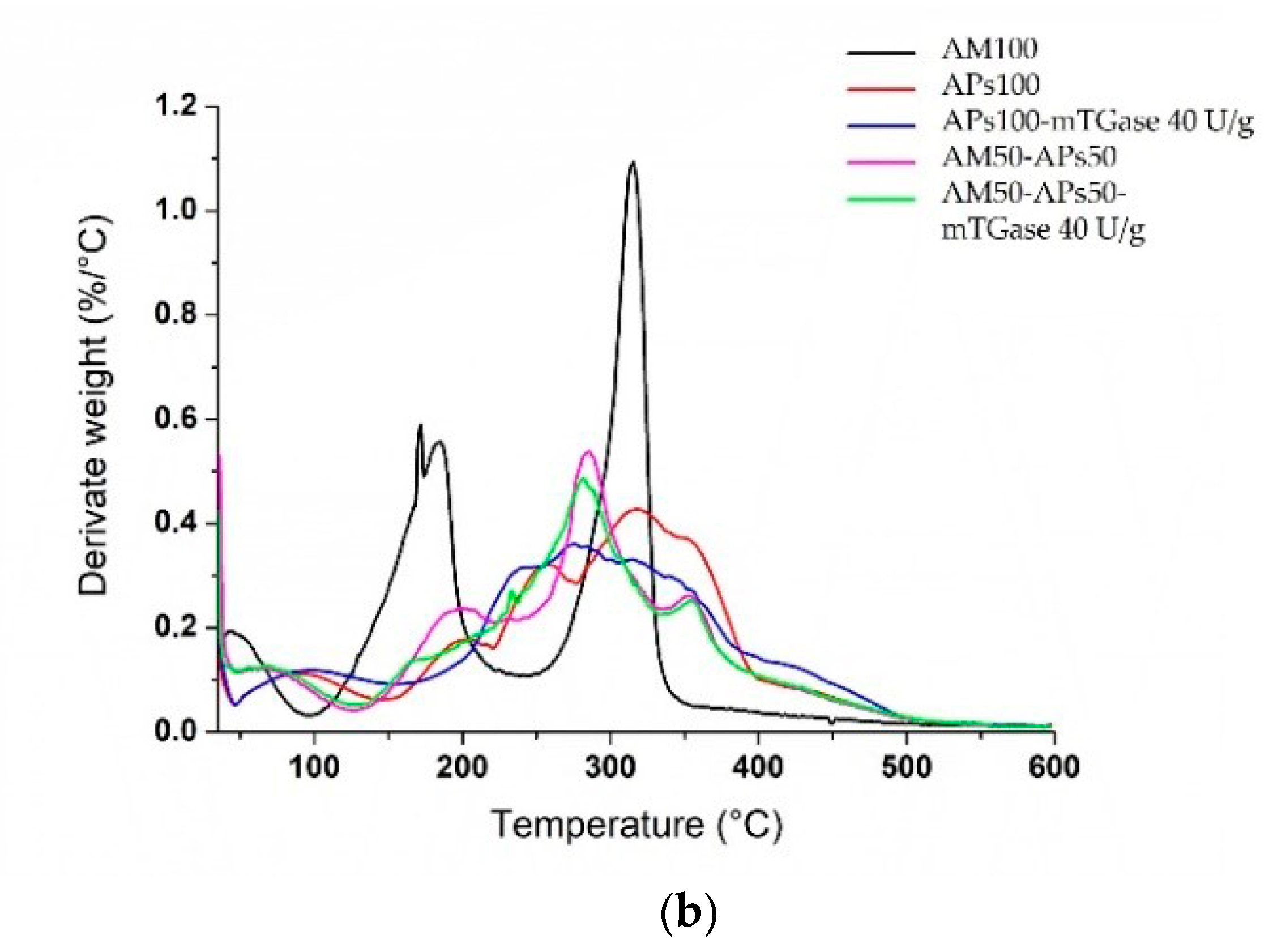
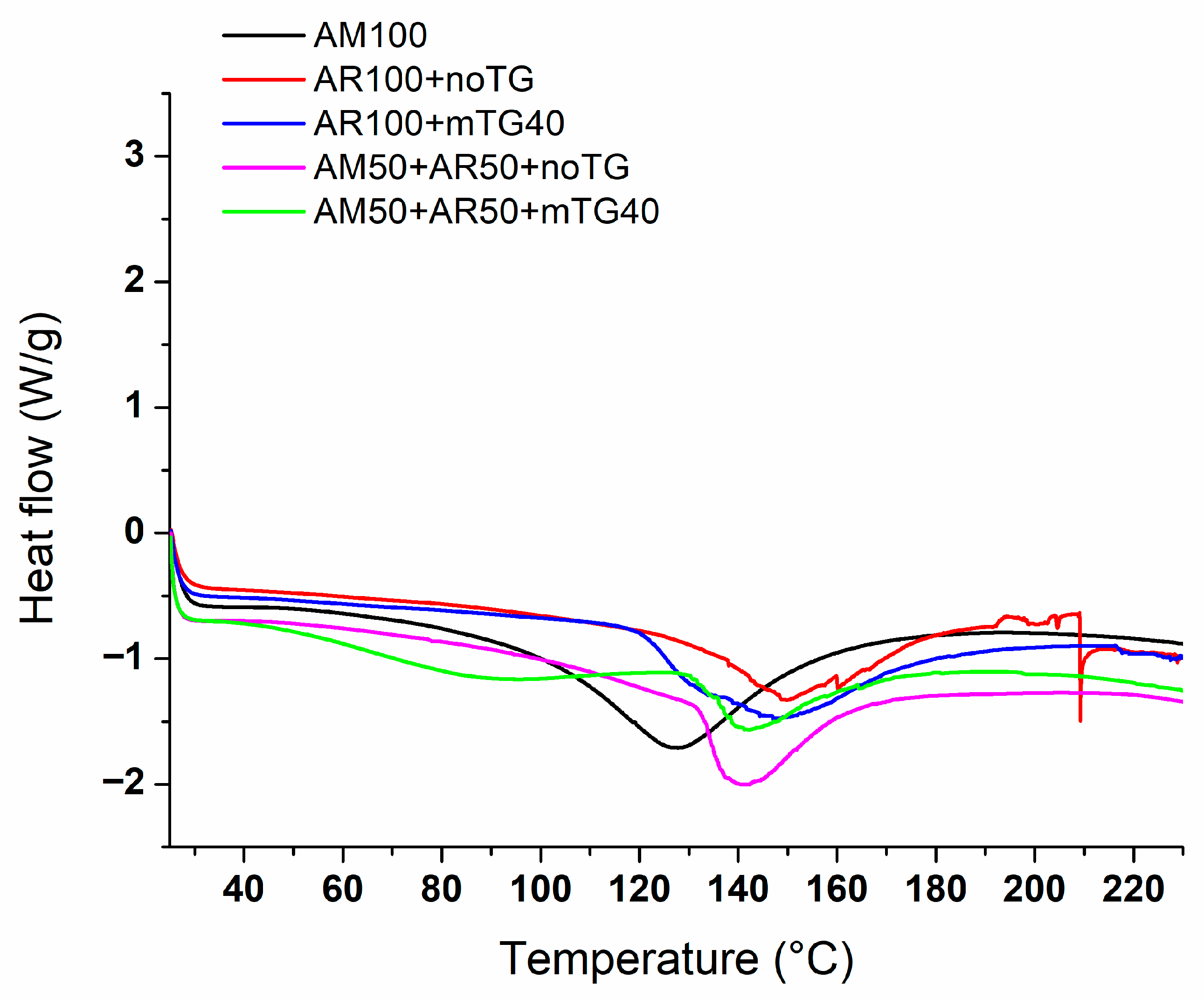
| APs-AM Ratio | Zeta Potential (mV) | APs-AM Ratio–mTGase | Zeta Potential (mV) |
|---|---|---|---|
| 0–100 | −10.85 ± 1.39 a | - | - |
| 15–85 | −37.60 ± 0.45 b | 15–85 | −37.58 ± 1.17 b |
| 30–70 | −46.20 ± 1.20 d | 30–70 | −39.32 ± 0.64 b |
| 50–50 | −46.24 ± 1.28 c,d | 50–50 | −42.80 ± 0.71 c |
| 100–0 | −52.87 ± 1.033 d | 100–0 | −43.23 ± 1.65 c |
| APs-AM Ratio | Opacity (A600nm/mm) | Density (g/cm3) | Thickness (µm) |
| 0–100 | 1.84 ± 0.34 a | 1.15 ± 0.002 a | 102.6 ± 5.86 a |
| 15–85 | 3.87 ± 0.02 d | 1.17 ± 0.05 a | 111.8 ± 7.01 a,b |
| 30–70 | 4.45 ± 0.09 e | 1.18 ± 0.09 a | 115 ± 16.4 a,b |
| 50–50 | 5.28 ± 0.16 g | 1.20 ± 0.10 a | 125.6 ± 12.05 b |
| 100–0 | 5.55 ± 0.18 h | 1.25 ± 0.04 a | 189.4 ± 25.2 d |
| APs-AM Ratio—mTGase | Opacity (A600nm/mm) | Density (g/cm3) | Thickness (µm) |
| 15–85 | 2.86 ± 0.11 b | 1.17 ± 0.02 a | 114.4 ± 5.98 a,b |
| 30–70 | 3.04 ± 0.07 b | 1.20 ± 0.17 a | 117.5 ± 12.23 a,b |
| 50–50 | 3.57 ± 0.01 c | 1.24 ± 0.14 a | 149.4 ± 1.34 c |
| 100–0 | 4.79 ± 0.04 f | 1.29 ± 0.02 a | 225.6 ± 22.34 e |
| APs-AM Ratio | WVP (g*mm*m−2*d−1*kPa−1) | CO2P (cm3*mm*m−2*d−1*kPa−1) |
| 0–100 | 8.68 ± 0.36 a | 0.42 ± 0.04 a |
| 15–85 | 6.16 ± 0.10 b | 0.42 ± 0.06 a |
| 30–70 | 3.56 ± 0.57 c | 0.25 ± 0.02 a,b,c |
| 50–50 | 3.27 ± 0.31 c | 0.24 ± 0.06 a,b |
| 100–0 | 2.89 ± 0.13 c | 0.30 ± 0.09 a,b,c |
| APs-AM Ratio—mTGase | WVP (g*mm*m−2*d−1*kPa−1) | CO2P (cm3*mm*m−2*d−1*kPa−1) |
| 15–85 | 3.010 ± 0.03 c | 0.35 ± 0.02 a,b |
| 30–70 | 2.74 ± 0.42 c | 0.12 ± 0.02 c |
| 50–50 | 2.35 ± 0.97 c,d | 0.16 ± 0.04 c |
| 100–0 | 1.87 ± 0.28 d | 0.45 ± 0.07 a |
Disclaimer/Publisher’s Note: The statements, opinions and data contained in all publications are solely those of the individual author(s) and contributor(s) and not of MDPI and/or the editor(s). MDPI and/or the editor(s) disclaim responsibility for any injury to people or property resulting from any ideas, methods, instructions or products referred to in the content. |
© 2023 by the authors. Licensee MDPI, Basel, Switzerland. This article is an open access article distributed under the terms and conditions of the Creative Commons Attribution (CC BY) license (https://creativecommons.org/licenses/by/4.0/).
Share and Cite
Famiglietti, M.; Zannini, D.; Turco, R.; Mariniello, L. Mechanical, Barrier and Thermal Properties of Amylose-Argan Proteins-Based Bioplastics in the Presence of Transglutaminase. Int. J. Mol. Sci. 2023, 24, 3405. https://doi.org/10.3390/ijms24043405
Famiglietti M, Zannini D, Turco R, Mariniello L. Mechanical, Barrier and Thermal Properties of Amylose-Argan Proteins-Based Bioplastics in the Presence of Transglutaminase. International Journal of Molecular Sciences. 2023; 24(4):3405. https://doi.org/10.3390/ijms24043405
Chicago/Turabian StyleFamiglietti, Michela, Domenico Zannini, Rosa Turco, and Loredana Mariniello. 2023. "Mechanical, Barrier and Thermal Properties of Amylose-Argan Proteins-Based Bioplastics in the Presence of Transglutaminase" International Journal of Molecular Sciences 24, no. 4: 3405. https://doi.org/10.3390/ijms24043405
APA StyleFamiglietti, M., Zannini, D., Turco, R., & Mariniello, L. (2023). Mechanical, Barrier and Thermal Properties of Amylose-Argan Proteins-Based Bioplastics in the Presence of Transglutaminase. International Journal of Molecular Sciences, 24(4), 3405. https://doi.org/10.3390/ijms24043405









